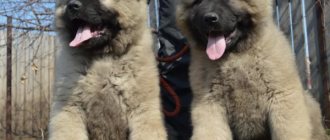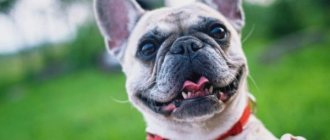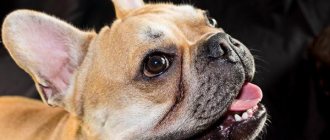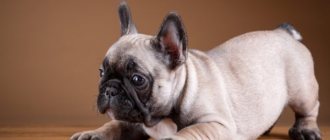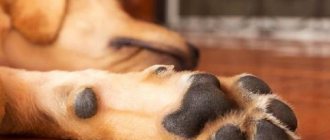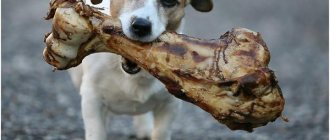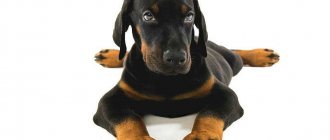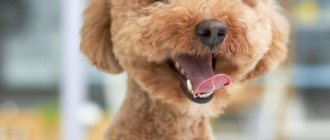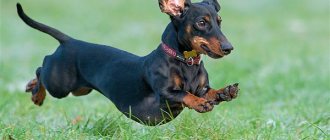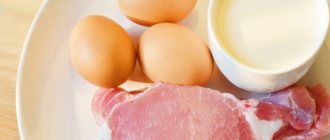One of the health problems that French bulldog owners face is obesity. In pursuit of weight normalization, many owners rely on tabular indicators from the Internet, without taking into account the characteristics of their dog and without consulting a veterinarian. For bulldogs, there are weight and height standards that set recommended limits. From the article you will learn: what is the normal weight for a baby bulldog and for an adult dog, how French puppies should gain weight, what diet a dog needs to avoid problems with excess weight.
Adult dog: weight norm
Like many other animals, French bulldogs have males that are taller and heavier than females. The RKF standard provides boundary values for the breed:
- male - from 10 to 16 kg with a height of 30 to 37 cm;
- female - from 8 to 13 kg with a height of 25 to 32 cm.
Among other dogs of similar sizes, French bulldogs have quite an impressive weight. The decent weight of the relatively small size of the dog can be explained by the fact that the ancestors of modern bulldogs were fighting dogs, which were characterized by large muscle mass. For breeding work, European specialists chose the ferocious English bulldog, decorative terriers and pugs. Subsequently, another type of French bulldog was bred - the dwarf.
Final thoughts
French Bulldogs are mischievous, one-of-a-kind dogs that have melted the hearts of many. French bulldogs, with their many genetic health problems, may require more veterinary care than other dogs.
Article author: Aaliyah Diamond . DVM Candidate - Cornell University College of Veterinary Medicine. Aaliyah Diamond has more than a decade of experience in animal hospitals, working with dozens of species, from dogs and cats to elephants and snow leopards. Her lifelong passion for helping animals has led to her currently pursuing a Doctor of Veterinary Medicine degree at Cornell University and helping Counselor Pavlisi educate pet parents.
Table of weight by age depending on the gender of the dog
| Males (age (in months)/weight (in kg) | Bitches age (in months)/weight (in kg) |
| 1 month - from 1 to 1.5 kg (birth weight from 200 to 300 g.) | 1 month - from 0.9 to 1.2 kg (birth weight from 170 to 280 g) |
| 2 months — from 2 to 2.3 kg | 2 months — from 1.5 to 2 kg |
| 3 months — from 3 to 5.5 kg | 3 months — from 1.8 to 4.2 kg |
| 4 months — from 4 to 6.5 kg | 4 months — from 3.5 to 5.4 kg |
| 5 months — from 5 to 7.6 kg | 5 months — from 4.5 to 6.3 kg |
| 6 months — from 6 to 9.5 kg | 6 months — from 5.4 to 7.5 kg |
| 7 months — from 6.5 to 10.5 kg | 7 months — from 5.6 to 8.6 kg |
| 8 months — from 7.4 to 11.5 kg | 8 months — from 6.5 to 9 kg |
| 9 months — from 8.2 to 13 kg | 9 months — from 7 to 10.5 kg |
| 10-11 months — from 9 to 15 kg | 10-11 months — from 7.5 to 13 kg |
| after a year - weight remains within 15-15.5 kg | after a year - weight remains within 12.5-14 kg |
Pedigree database Ingrus
There is an electronic unified pedigree database in which you can find out information about the dog’s ancestors and the titles of relatives by the puppy’s name.
The only condition is that they must be entered into this system by the breeder.
To find the necessary information on French bulldogs, you need to open Ingrus on the Internet at https://ingrus.net/frbull/, select the “search for dog” column, then enter the known data and get information about ancestors up to the eighth generation. This is convenient because the owner can see not only information about titles and names, but also see what the puppy’s parents and great-grandparents looked like in order to get an idea of its future appearance.
Growth phases: to what age do French bulldogs grow?
A newborn puppy weighs less than a kilogram, but from the first months it begins to quickly gain weight. With intense uncontrolled feeding, the baby will become plump, even fat. During this period, it is necessary to create a diet that will provide the puppy with all the necessary nutrients, but will not lay the foundation for obesity.
The French Bulldog puppy continues to grow rapidly until he is ten or eleven months old. Then the baby begins to grow in width and forms muscle mass. Fluctuations in weight gain slow down. First, the head develops and grows, then the chest and muscles. By the age of one and a half years, the exterior of the French bulldog is fully formed.
Important: the average standard indicators do not mean that all bulldogs should develop within the specified weight and height limits. Dwarf brothers weigh 6-10 kg less than usual, and the height at the withers is less than 25 cm.
Breed standard: height, weight, appearance
The size of a French bulldog will differ depending on the gender of the pet. The RKF establishes the following standards for the French bulldog:
- weight of males – 10-25 kilograms, body weight of females – 8-12 kilograms;
- height at the withers of a male is 30-35 centimeters, height of a female is 25-30 centimeters.
The animal weighs a lot when comparing the weight indicator with the small dimensions of the dog’s body. If you compare bulldogs with other purebred dogs of similar height, you will find that Frenchies are much more massive. The large body weight of all representatives of the bulldog family is associated with the characteristics of the breed, the ancestors of which are muscular and vicious fighting dogs.
French bulldogs were bred by breeders from Europe who crossed English bulldogs, pugs, and terriers. From ferocious and good-natured parents came a standard and dwarf Frenchie. As stated above, the normal average weight of a French bulldog is 8-14 kilograms, and excess body weight of 300 or 400 grams is allowed.
It should be noted that while maintaining the breed type, a bulldog baby can grow up to about a year. After this, the animal begins to get fat, while gaining muscle mass.
A pet's skull depends on heredity and comes in three main shapes:
- severe;
- square;
- narrow.
According to international standards, the French Bulldog is characterized by a square head with wrinkles or folds, as well as a wide and at the same time flat skull in the area of the ears. The animal's forehead is rounded, resembling a dome.
The bulldog's chest resembles a barrel with a convex front part, it is well developed. The animal is characterized by the presence of a round, sloping croup with a wide rump, a short but wide and muscular neck. It is strictly forbidden to allow the formation of folds or excess fat on the neck, as well as sagging of the back. The animal's forelimbs are strong and straight with tucked elbows.
The hind legs are curved at an angle, equipped with muscular thighs. When a bulldog runs, its tail rises above its back. Often a puppy is born with a longer tail than indicated in the characteristics. In such cases, experts advise, as an exception, to dock the pet’s tail on the fifth day after its birth. Testicles that are not fully descended or not descended into the scrotum at all can become a problem.
The standards allow the following colors of short, coarse coat:
- all shades of red in tandem with a black mask;
- a uniform fawn color throughout the body, which may be lighter in the sternum, abdomen, and inner thighs, complemented by the obligatory dark mask;
- brindle with bright stripes on a red or dark background.
Breeders pay attention to the fact that completely black color is not allowed according to the standard. A completely snow-white animal or the presence of individual areas of this color on its body is undesirable. White animals with painted eyelids, nose, and claws are not allowed for mating; they are characterized by complete or partial deafness, which is inherited.
It is worth noting that the RKF French bulldog breed standard classifies as serious defects a very long or short muzzle, a constantly protruding tip of the tongue, and a light shade of eyes reminiscent of a bird of prey. The presence of a straight bite, weakened pigmentation of the tip of the nose or eyelids can become a problem. Gray, dark chocolate, cream, and tricolor colors are not allowed according to the standard. Incorrectly colored coats cause exclusion from dog shows and from further mating.
According to international and local standards, disqualifying defects clearly include:
- aggressiveness;
- cowardice;
- presence of physical defects;
- behavioral deviations;
- traits atypical for the breed;
- absence of nostrils;
- jaws shifted to the side;
- drooping ears;
- the color of the nose is different from black;
- presence of a scissor bite;
- different color of the right and left eyes;
- the presence of an ingrown tail or its complete absence;
- presence of dewclaws on the hind legs;
- loose hocks;
- curly, hard, elongated wool, reminiscent of wire;
- chronic difficulty breathing;
- acute sensorineural deafness.
You need to know exactly how much a French bulldog weighs, since severe deviations from the norm will cause disqualification from exhibitions.
Factors affecting a dog's weight
First of all, weight depends on the gender of the animal - males differ from females in height, weight and appearance - males are more masculine, muscular and aggressive.
In addition, the weight indicators are influenced by the following factors:
- climate;
- genetics - frequent obesity;
- dietary features - small amounts or low-calorie foods;
- concomitant diseases and pathologies of the dog - chronic diseases will prevent you from gaining weight;
- puppy's diet - often babies raised on artificial formula do not gain weight as rapidly as those raised on mother's milk. Artificial ones most often do not become strong; they are distinguished by their grace and small size.
The final formation of a dog occurs by the age of two. Interestingly, a one-year-old puppy can be heavier than an adult two-year-old dog. By this age, the French become more muscular and fit.
Interesting: show animals should be more graceful and light than simple purebred pets.
Documentation
Upon purchase, the following documents are issued:
- “Puppy metric” or “puppy card”. It indicates: breed, nickname, color, date of birth, brand, number of the mating act, information about the parents indicating nicknames, titles, pedigree numbers and owners. In the “puppy owner” column, enter the buyer’s details and address. The metric has a number and is certified by the signature of the chairman and the seal of the club or nursery indicating his address and telephone number.
- Contract of sale. If it is not drawn up, then the puppy’s metric has the force of this document, and then the pedigree.
- If you plan to participate in exhibitions or transport, you must have an International Veterinary Passport, which contains information about vaccinations performed.
- If the puppy is exported abroad, you need permission from the Russian Canine Federation, addressed to the customs authorities, as well as a veterinary certificate.
The pedigree is issued based on metrics after purchase. It indicates the dog's ancestors for at least three generations.
Deviations from normal weight
One of the problems with weight is intense loss. The main reason is rickets. A consultation with a veterinarian is necessary to rule out other causes and obtain advice on the treatment of rickets.
This condition develops due to the lack of necessary minerals in the diet and disruption of the functioning of certain glands.
Important: puppies and young dogs are most often affected by the disease. In winter, the risk of developing the disease increases several times.
The main signs of rickets:
- pronounced curvature of the paws;
- thickening of joints;
- characteristic sagging in the back area.
You need to start therapy as early as possible, it should only be carried out under the supervision of a specialist. Self-medication will cause more harm than good to a young dog and such problems will persist for the rest of his life. In treatment, it is especially important to establish proper nutrition for the French bulldog.
Principles:
- six meals a day are required for a puppy, two meals a day for an adult dog;
- Feeding is carried out strictly at the same time - the regime is very important.
Another problem common to bulldogs is obesity. The main causes of obesity are overfeeding, an unbalanced diet, and a sedentary lifestyle of the dog.
Principles of obesity treatment:
- reducing the calorie content of the menu by 30-40%;
- increasing the dog's activity;
- increasing the percentage of plant foods in the bulldog's bowl.
At the beginning, the dog will beg for an additional portion, so you should not give in to him. Soon he will get used to the new diet, his health will be in order. After all, obesity is always accompanied by: problems with the heart and joints, shortness of breath, and breathing problems.
As a rule, in case of obesity, additional studies are prescribed, since the cause can be not only nutritional deficiencies, but also certain diseases:
- heart diseases;
- endocrine disorders;
- hormonal imbalances;
- genetic pathologists;
- stress and depression.
How to treat obesity?
Due to overfeeding and insufficient activity in a city apartment, the dog begins to suffer from obesity. And this leads to apathy, breathing difficulties, heart problems, stress on the spine and joints of the limbs.
In this case, the dog owner needs to know how to feed the pet so that it loses extra pounds. In addition, it is necessary to increase the dog's physical activity.
IMPORTANT!
The calorie content of food for a bulldog should be reduced by 30-40%.
At first, the dog will ask for more, begging you with his pained gaze, but do not give in to provocations. Once you endure this period, then it will be easier - the bulldog will get used to this diet and will no longer ask for more food.
Extend your walks outdoors. Play more outdoor games - you can use a ball or plastic bones for this.
It is advisable that the diet for the animal be developed by a veterinarian. Most likely, he will advise giving the dog low-calorie plant foods, such as boiled carrots, green beans, and cabbage. You will need vitamin supplements, which should also be prescribed by a specialist.
In addition, the veterinarian will probably advise examining an obese dog, since sometimes it is not only a sedentary lifestyle and good nutrition that lead to excess weight in a pet.
This condition can develop against the background of certain disorders in the body - these may be:
- cardiac disorders;
- disruptions in the endocrine system;
- hereditary factor;
- hormonal imbalance;
- stressful situations.
Puppies
French bulldog puppies are perpetual motion machines. Sometimes babies simply forget to eat, so it’s difficult to overfeed them. When switching to independent nutrition, special attention should be paid to the process of introducing new ingredients. They are given in small pieces. It’s better to start with meat or porridge, gradually introducing vegetables and fruits. During this period, the general condition and stool of the baby are carefully monitored.
Small Bulldog food percentage:
- 65% - protein;
- 35% - carbohydrates.
Up to a year, the serving size should be 8-10% of the dog’s weight. If the baby eats ready-made food, then the choice is made from premium diets. It is worth choosing age-appropriate foods. Many producers have breed lines.
Diet tips
When choosing a menu, consider 4 circumstances:
- “French people” easily gain excess weight;
- they are susceptible to allergies;
- Representatives of the breed quickly wear down their teeth, which is why they are given almost no bones;
- Calorie content is calculated based on the dog’s physical activity.
Feeding the puppies
It is almost impossible to overfeed babies due to their hyperactivity: puppies are so involved in learning about the reality around them that they simply forget to eat.
When switching to independent nutrition (natural), unfamiliar ingredients are introduced gradually, mainly in the form of thick soup or porridge. First, they give scalded pieces of meat and porridge with milk, a little later diluting the diet with chopped vegetables (raw and boiled).
Puppy food should consist of approximately 65% proteins (meat, offal, boiled fish, cottage cheese) and 35% carbohydrates (cereals, vegetables, fruits).
The number of feedings (per day), depending on age, looks like this:
- 1-2 months – 6 times;
- 3 months – 5 times;
- 5 months – 4 times;
- 6 months – 3 times;
- 8-12 months – 2 times.
Important! Until the puppy is one year old, he is allowed to eat a volume of food equal to 8-10% of his own weight. The excess will be needed in the future to build muscle mass: this is especially important for a growing male dog.
Nutrition for an adult dog
When breastfeeding, focus on raw foods . The best meat is considered to be lean beef, which is doused with boiling water or boiled (10 minutes) and finely chopped, but not into minced meat.
Also on the French Bulldog menu include:
- horse meat, lamb and rabbit meat (20 g per 1 kg of pet’s weight);
- beef liver, tripe and heart;
- buckwheat, rolled oats, rice and barley;
- fermented milk products, including cottage cheese;
- greens (parsley, sprouted cereals and dandelion);
- vegetables, such as bell peppers, carrots, pumpkin and zucchini;
- sea fish fillet, freed from bones;
- eggs (twice a week);
- fruits and vitamin-mineral supplements.
Always be aware of your Frenchie's food sensitivities before you decide to make any changes to your dog's usual diet.
Briefly about the main thing
- French bulldogs are small dogs with quite impressive weight figures.
- Males are larger and taller than females.
- Dogs are prone to rickets and obesity.
- Intensive growth of puppies continues until 11 months, then the dog builds muscle mass.
- Both natural food and ready-made food are suitable for nutrition.
How much does your French Bulldog weigh? How did he develop as a child? Have you ever had to deal with rickets or obesity in your pet? Share your stories in the comments, please. Your experience is very important to us and our readers.
What affects height and body weight?
Often the weight and height of French bulldogs lags behind normal values. This breed is prone to various diseases that affect the weight of the animal. This can be either obesity or dystrophy caused by rickets.
The weight and height of a French bulldog are mainly influenced by the dog's genetics. In second place is the influence of the nutrition of a small puppy , as well as how long he is breastfed.
It has been noticed that artificial puppies gain weight more slowly and ultimately grow not so large and massive.
After the puppy is weaned from its mother, the dog's diet plays an important role.
Thus, the following nutritional deficiencies will affect the weight gain of a French bulldog:
- small amount of food in volume;
- low calorie food.
As a result, the dog grows much shorter and lighter than standard standards.
Another factor in underweight can be chronic diseases of the animal.
Breed characteristics and character
The breed has a very sociable character. French bulldogs are very attached to their owners. They love children and usually obediently tolerate any manifestations of feelings on their part. These dogs very sensitively sense the mood of their owners; they greet guests joyfully, but only if the owners themselves are happy with the guests.
Shows true fearlessness towards uninvited guests. Does not tolerate loneliness well, because it is very dependent on the owner, and is ready not to be separated from him at all if there is such an opportunity. Active, smart, curious. It's easy to learn new commands.
French bulldog age 3 years
Balanced, never shows aggression without a reason. Loves praise and affection. As for their personality traits, these dogs should be kept with you when walking; their playful, curious disposition can often lead them too far from their owner.
Very young children should not be allowed near, in order to avoid manifestations of parental instinct. But overall, he is a loyal friend, a ringleader, smart, brave and very sociable.
What to do if you are obese
If your dog is gaining weight too quickly, it is also important to contact your veterinarian. In most cases, the owner is to blame for a dog's obesity by overfeeding the pet. The animal must have nutrition that strictly corresponds to the norm. The dog needs to be fed at the same time, and the calorie content needs to be reduced by about 30%.
It is very important to strictly adhere to all recommendations and not to give the animal excess food, although at first it will constantly beg. However, after some period the pet will get used to the new diet. It is best to discuss the diet with your veterinarian. You will also need to select the necessary vitamins and minerals
It is recommended to walk the dog more, play with it, and make sure it moves more. This will also help you get rid of excess weight.
In addition, it is recommended to conduct additional research, because excess weight can be caused by various pathologies:
- diseases of the cardiovascular system,
- endocrine diseases,
- heredity,
- hormonal imbalance,
- stress and depression.
It is necessary to eliminate all negative factors in order to normalize the weight of the animal.
Exercise is very beneficial for bulldogs
Care and maintenance
Someone is about to be washed
- Brush your pet 1-2 times a week with a brush for short-haired animals or a special mitten. This will help to give a useful massage, remove dead hair and street dust.
- It is enough to bathe an animal with a special shampoo several times a year. After water procedures, dry the body well with a towel; you can use a hairdryer if the dog is not afraid of it.
- You need to brush your teeth with a specialized toothpaste approximately once a week. This procedure can be replaced by buying your French bulldog special bones that help remove plaque and tartar.
- Check your ears regularly - due to their anatomical structure, little wax accumulates, but dirt and insects easily enter. Clean them once a week with a cotton swab or swab. Remember that there should be no liquid or strong unpleasant odor in the ears.
- It is enough to trim the claws once a month, smoothing the ends with a nail file. Carry out the procedure carefully so as not to catch the capillaries.
- Keep an eye on the skin folds on the face – food particles and dirt often get trapped there. It is necessary to wipe them once a day with a soft, damp cloth to prevent the formation of diaper rash.
- Light colored bulldogs experience a small amount of discharge from the eyes. This is normal, but it is advisable to carefully remove all dirt. If there is increased tearing or clouding of the eyes, contact your veterinarian immediately - an infection or allergy is possible.
- The French bulldog breed is not demanding in terms of physical activity - in a spacious apartment the dog can live with virtually no walks. This greatly simplifies its maintenance in urban environments. But the less the pet moves, the more carefully the menu should be drawn up.
